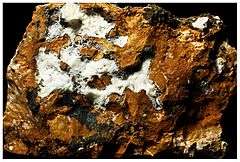Sauconite
| Sauconite | |
|---|---|
|
Sauconite (reddish brown) | |
| General | |
| Category | Phyllosilicate mineral |
| Formula (repeating unit) | Na0.3Zn3(SiAl)4O10(OH)2·4H2O |
| Strunz classification | 9.EC.45 |
| Crystal system | Monoclinic |
| Crystal class |
Prismatic (2/m) H-M symbol: (2/m) |
| Space group | C2/m |
| Identification | |
| Color | Reddish brown, brown, brownish yellow, mottled |
| Crystal habit | Clayey; as small micaceous plates in laminated to compact masses |
| Cleavage | Perfect on {001} |
| Mohs scale hardness | 1 - 2 |
| Luster | dull |
| Diaphaneity | Translucent |
| Specific gravity | 2.45 |
| Optical properties | Biaxial (-) |
| Refractive index | nα = 1.550 - 1.580 nβ = 1.590 - 1.620 nγ = 1.590 - 1.620 |
| Birefringence | δ = 0.040 |
| Dispersion | r > v strong |
| References | [1][2][3] |
Sauconite is a complex phyllosilicate mineral of the smectite clay group, formula Na0.3Zn3(SiAl)4O10(OH)2·4H2O. It forms soft earthy bluish white to red-brown monoclinic crystals typically massive to micaceous in habit. It has a Mohs hardness of 1 to 2 and a specific gravity of 2.45. Optically it is biaxial positive with refractive index values of nα = 1.550 - 1.580, nβ = 1.590 - 1.620 and nγ = 1.590 - 1.620.[1][3] It is found in vugs and seams in the oxidized zones of zinc and copper deposits. It occurs in association with hemimorphite, smithsonite, chrysocolla, coronadite and various iron oxides.
It was named for the Saucon Valley in Pennsylvania, where it was originally discovered in 1875.[2]
References
This article is issued from Wikipedia - version of the 11/21/2016. The text is available under the Creative Commons Attribution/Share Alike but additional terms may apply for the media files.
